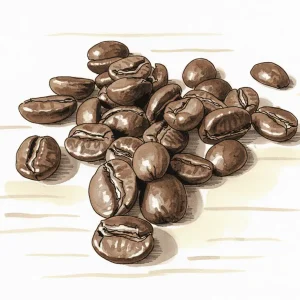Bourbon
Bourbon coffee stands out for its gentle sweetness, balanced acidity, and enticing aromas of caramel and subtle fruit. Originating on Réunion Island, this Arabica variety delivers a smooth, nuanced cup prized by specialty roasters and coffee enthusiasts across the globe.
Bourbon Beans
Showing 1–16 of 107 results
De goedkoopste prijzen per 1 kg worden weergegeven
-
Altura, Mexico, Decaf
van Screaming Beans€ 55,56 -
Amkeni
€ 46,80 -
Amkeni, Tanzania
van Man Met Bril€ 61,20 -
Arcila, Colombia Decaf
van Man Met Bril€ 64,00 -
Bant Sawk
€ 46,80 -
Bio Blend
€ 29,50 -
Brasil Yellow Bourbon
van Blooss Coffee€ 99,80 -
Brasil Yellow Bourbon (Fazenda Mariano)
van Gebrand op Smaak -
Brasil Yellow Bourbon (Mantiqueira Mountains)
van Gebrand op Smaak -
brazil – serra negra
€ 33,75 -
Brazil Classic – Peaberry
€ 118,40 -
Brazilie • Monte Belo
van De Eenhoorn€ 31,90 -
Brazilië | Ellen Fontana (espresso)
van Henry’s Coffee€ 28,50 -
Brazilië Capricornio Limpido – Direct Trade – vers gebrand – 1000 gram
van De Koepoort€ 25,50 -
Brazilië Capricornio Pionero – Direct Trade – vers gebrand – 1000 gram
van De Koepoort€ 29,95 -
Brazilië Capricornio Timbo – Direct Trade – vers gebrand – 1000 gram
van De Koepoort€ 99,80
More About Bourbon
History and Origins
Bourbon coffee traces its origins to the early 18th century on the island of Bourbon (now Réunion). French growers planted Arabica seeds from Yemen there, after which the plants naturally adapted and became more productive than their Typica ancestors. This new variety later spread to mainland Africa and then to Latin America, where it laid the foundation for one of the most influential Arabica lineages in the coffee world.
Main Cultivation Regions and Terroir
Bourbon thrives in several renowned coffee regions, such as Brazil, El Salvador, Rwanda, and Burundi. Each area has a unique combination of soil, climate, and altitude, resulting in subtle flavor differences. In El Salvador, caramel-like notes often emerge, while Bourbon from Rwanda and Burundi is known for bright, fruity tones with lively acidity. In Brazil, Yellow Bourbon is especially cherished for its gentle, nutty sweetness. This variety typically grows at elevations between 1,100 and 2,000 meters, which gives it its characteristic depth and complexity.
Flavor Profile and Aroma
A cup of Bourbon is generally smooth, balanced, and slightly sweeter than other Arabica varieties. Common tasting notes include chocolate, caramel, and nuts, sometimes complemented by fruity or citrus accents, depending on origin. The acidity is usually medium, providing a pleasant, non-overpowering freshness. Combined with a medium body and silky mouthfeel, Bourbon offers a refined experience that appeals to many coffee enthusiasts.
Processing Methods and Their Influence
Bourbon beans are well suited to a range of processing methods, each with its own impact on flavor. A washed process emphasizes clarity and brightness, bringing any fruit or citrus notes to the fore. In pulped natural (also called the honey process), the focus shifts to sweetness and a fuller mouthfeel. Natural (unwashed) processing can add heavier, jam-like fruit tones but may sometimes push acidity into the background. The choice of method often depends on regional conditions and the desired flavor profile.
Brewing Methods for the Best Result
Thanks to its balanced character, Bourbon shines with various brewing methods. A pour-over (such as Hario V60 or Chemex) highlights delicate aromas and a clean finish. Using a cafetière (French press) creates a creamier texture, allowing the natural sweetness to come forward. As espresso, Bourbon maintains a syrupy body and mild acidity with subtle chocolate notes. Many roasters praise Bourbon espresso for its harmony with milk, resulting in velvety cappuccinos or flat whites.
Influence of Climate and Disease Resistance
Ideal growing conditions for Bourbon consist of cool temperatures and regular rainfall, which allow the berries to ripen slowly for deeper flavor development. However, this variety is susceptible to diseases such as coffee rust and various pests. Due to global warming, these threats can now also occur at higher altitudes, presenting additional challenges. Many farmers address this problem by carefully managing shade trees, improving soils, and applying other agronomic techniques.
Comparison with Other Arabica Varieties
Bourbon yields more than Typica while still maintaining high cup quality. Compared to modern hybrids like Caturra or Catuaí, Bourbon is less resistant to diseases, but often richer in flavor and sweetness. Other specialty varieties, such as Geisha, are known for floral and tea tones, while Bourbon offers a more classic and comforting flavor. This variety also serves as the genetic base for many other varieties that have inherited some of Bourbon's most attractive characteristics.
Popularity among Roasters and Professionals
Roasters appreciate Bourbon for its versatility and depth. A light roast accentuates its bright, fruity notes, while a medium roast brings out caramel and chocolate tones. This makes Bourbon popular in cupping competitions and within the specialty segment. Due to its consistent quality and approachable flavor, it is often considered a 'benchmark', recognizable and beloved by a wide audience.
Grind Settings and Water Temperature
A good burr grinder is essential for a consistent grind. A medium grind typically works well for pour-over, a slightly coarser grind for a French press, and a fine grind for espresso. The water temperature should be between 90 and 96°C for optimal extraction. Light roasts sometimes benefit from the higher end of this range for extra clarity, while dark roasts benefit from slightly lower temperatures to avoid bitterness.
Bourbon (Arabica) has built its reputation with a soft sweetness, captivating aromas, and a long history. From the high-altitude plantations to specialty cafés, this classic variety continues to attract enthusiasts with its timeless mix of balance and refinement.

